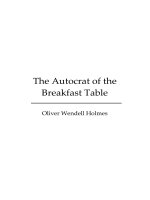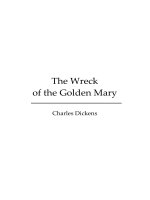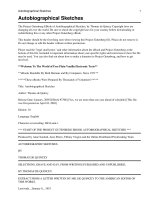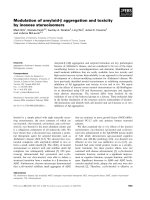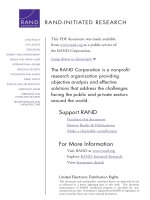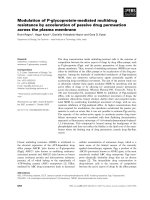Modulation of papaya wine flavour compound formation by yeasts
Bạn đang xem bản rút gọn của tài liệu. Xem và tải ngay bản đầy đủ của tài liệu tại đây (5.32 MB, 290 trang )
MODULATION OF PAPAYA WINE FLAVOUR
COMPOUND FORMATION BY YEASTS
LEE PIN ROU
NATIONAL UNIVERSITY OF SINGAPORE
2012
MODULATION OF PAPAYA WINE FLAVOUR
COMPOUND FORMATION BY YEASTS
LEE PIN ROU
(B. Appl. Sc.(Hons.), National University of Singapore)
A THESIS SUBMITTED
FOR THE DEGREE OF DOCTOR OF PHILOSOPHY
DEPARTMENT OF CHEMISTRY
NATIONAL UNIVERSITY OF SINGAPORE
2012
i
THESIS DECLARATION
I hereby declare that this thesis is my original work and it has been written by
me in its entirety, under the supervision of Dr Liu Shao Quan, (in the Food Science
and Technology research laboratory, S13-05), Chemistry Department, National
University of Singapore, between January 2009 and November 2012.
I have duly acknowledged all the sources of information which have been used
in the thesis.
This thesis has also not been submitted for any degree in any university
previously.
The content of the thesis has been partly published in:
1. Lee, P. R., Chong, I. S. M., Yu, B., Curran, P., & Liu, S. Q. (2012). Effects of
sequentially inoculated Williopsis saturnus and Saccharomyces cerevisiae on
volatile profiles of papaya wine. Food Research International, 45, 177–183.
2. Lee, P. R., Kho, S. H. C., Yu, B., Curran, P., & Liu, S. Q. (2012). Yeast ratio is
a critical factor for sequential fermentation of papaya wine by Williopsis
saturnus and Saccharomyces cerevisiae. Microbial Biotechnology. (In press).
DOI:10.1111/1751-7915.12008.
3. Lee, P. R., Yu, B., Curran, P., & Liu, S. Q. (2011). Impact of amino acid
addition on aroma compounds in papaya wine fermented with Williopsis mrakii.
South African Journal of Enology and Viticulture, 32, 220–228.
4. Lee, P. R., Yu, B., Curran, P., & Liu, S. Q. (2011). Effect of fusel oil addition
on volatile compounds in papaya wine fermented with Williopsis saturnus var.
mrakii NCYC 2251. Food Research International, 44, 1292–1298.
ii
5. Lee, P. R., Li, X., Yu, B., Curran, P., & Liu, S. Q. (2011). Non-Saccharomyces
yeasts and wine. In: A. S. Peeters (Ed.), Wine: Types, Production and Health
(Chapter 12). Hauppauge, New York, USA: Nova Science Publishers. ISBN:
978-1-61470-804-9.
6. Lee, P. R., Ong, Y. L., Yu, B., Curran, P., & Liu, S. Q. (2010). Evolution of
volatile compounds in papaya wine fermented with three Williopsis saturnus
yeasts. International Journal of Food Science and Technology, 45, 2032–2041.
7. Lee, P. R., Ong, Y. L., Yu, B., Curran, P., & Liu, S. Q. (2010). Profile of
volatile compounds during papaya juice fermentation by a mixed culture of
Saccharomyces cerevisiae and Williopsis saturnus. Food Microbiology, 27,
853–861.
8. Lee, P. R., Yu, B., Curran, P., & Liu S. Q. (2010). Kinetics of volatile organic
compounds during papaya juice fermentation by three commercial wine yeasts.
Nutrition & Food Science, 40, 566–580.
Lee Pin Rou
1
st
November 2012
Name Signature Date
iii
ACKNOWLEDGEMENTS
First and foremost, I would like to express my deepest and sincere gratitude to
my supervisor Dr Liu Shao Quan for his valuable advice, supervision, guidance and
encouragements throughout the entire project. I feel honoured to have him as my
supervisor and I have learned a lot from his valuable ideas, profound knowledge, and
rich research experience. I am also deeply grateful for his kindness and patience
throughout the four years and his countless efforts in guiding me to complete my
research project and thesis.
Next, I would like to extend my gratitude to Dr Yu Bin, who has provided me
with meticulous guidance, and timely advice on the method development for the solid
phase microextraction (SPME) and gas chromatography-mass spectrometry (GC-MS).
I would also like to sincerely thank the flavourists from Firmenich for their precious
time and efforts during the wine sensory evaluations.
I would like to express my warmest appreciation to my previous honours year
and UROPS students, Miss Ong Yuen-Ling Irene, Miss Irene Saksono, Miss Chong
Siew-May Irene, Miss Kho Hui-Chern Stephanie, Mr Saputra Anthony and Mr Toh
Mingzhan, for their help and commitment in conducting some fermentation
experiments in my research project. I would also like to take this opportunity to thank
my fellow postgraduates, Mr Li Xiao, Ms Sun Jingcan, Ms Cheong Mun Wai, Ms
Chan Li Jie and Ms Chen Dai, for their advice, technical assistance and moral support
rendered throughout the project. I am also grateful for all the technical assistance
provided by the staff and laboratory technicians of the Food Science and Technology
Programme. Last but not least, I would like to thank my family members and my
husband for their unwavering support and encouragement in my life.
iv
PUBLICATIONS LIST
List of publications derived from this thesis
1. Lee, P. R., Chong, I. S. M., Yu, B., Curran, P., & Liu, S. Q. (2013). Effect of
precursors on volatile compounds in papaya wine fermented by mixed yeasts.
Food Technology and Biotechnology, 51, 92–100.
2. Lee, P. R., Chong, I. S. M., Yu, B., Curran, P., & Liu, S. Q. (2012). Effects of
sequentially inoculated Williopsis saturnus and Saccharomyces cerevisiae on
volatile profiles of papaya wine. Food Research International, 45, 177–183.
3. Lee, P. R., Kho, S. H. C., Yu, B., Curran, P., & Liu, S. Q. (2012). Yeast ratio is
a critical factor for sequential fermentation of papaya wine by Williopsis
saturnus and Saccharomyces cerevisiae. Microbial Biotechnology. (In press).
DOI:10.1111/1751-7915.12008.
4. Chan, L. J., Lee, P. R., Li, X., Chen, D., Liu, S. Q., & Trinh, T. T. T. (2012).
Tropical fruit wine: an untapped opportunity. In D. Cabel (Ed.), Food &
Beverage Asia. Dec/Jan 2011/2012 (pp. 48–51). Singapore: Pablo Publishing
Pte Ltd. ISSN: 2010-2364.
5. Lee, P. R., Yu, B., Curran, P., & Liu, S. Q. (2011). Impact of amino acid
addition on aroma compounds in papaya wine fermented with Williopsis mrakii.
South African Journal of Enology and Viticulture, 32, 220–228.
6. Lee, P. R., Yu, B., Curran, P., & Liu, S. Q. (2011). Effect of fusel oil addition
on volatile compounds in papaya wine fermented with Williopsis saturnus var.
mrakii NCYC 2251. Food Research International, 44, 1292–1298.
7. Lee, P. R., Li, X., Yu, B., Curran, P., & Liu, S. Q. (2011). Non-Saccharomyces
yeasts and wine. In: A. S. Peeters (Ed.), Wine: Types, Production and Health
(Chapter 12). Hauppauge, New York, USA: Nova Science Publishers. ISBN:
978-1-61470-804-9. (In press)
v
8. Lee, P. R., Ong, Y. L., Yu, B., Curran, P., & Liu, S. Q. (2010). Evolution of
volatile compounds in papaya wine fermented with three Williopsis saturnus
yeasts. International Journal of Food Science and Technology, 45, 2032–2041.
9. Lee, P. R., Ong, Y. L., Yu, B., Curran, P., & Liu, S. Q. (2010). Profile of
volatile compounds during papaya juice fermentation by a mixed culture of
Saccharomyces cerevisiae and Williopsis saturnus. Food Microbiology, 27,
853–861.
10. Lee, P. R., Yu, B., Curran, P., & Liu S. Q. (2010). Kinetics of volatile organic
compounds during papaya juice fermentation by three commercial wine yeasts.
Nutrition & Food Science, 40, 566–580.
List of related publications
1. Lee, P. R., Toh, M., Yu, B., Curran, P., & Liu, S. Q. (2013). Manipulation of
volatile compound transformation in durian wine by nitrogen supplementation.
International Journal of Food Science and Technology, 48, 650–662.
2. Lee, P. R., Boo, C. X., & Liu, S. Q. (2013). Fermentation of coconut water by
probiotic Lactobacillus acidophilus and Lactobacillus casei. Annals of
Microbiology. (In press). DOI: 10.1007/s13213-013-0607-z.
3. Lee, P. R., Tan, R. M., Yu, B., Curran, P., & Liu, S. Q. (2012). Sugars, organic
acids, and phenolic acids of exotic seasonable tropical fruits. Nutrition & Food
Science. (In press).
4. Lee, P. R., Saputra, A., Yu, B., Curran, P., & Liu, S. Q. (2012).
Biotransformation of durian pulp by mono- and mixed-cultures of
Saccharomyces cerevisiae and Williopsis saturnus. LWT-Food Science and
Technology, 46, 84–90.
vi
5. Tan, A. W. J., Lee, P. R., Seow, Y. X., Ong, P. K. C., & Liu, S. Q. (2012).
Volatile sulphur compounds and pathways of L-methionine catabolism in
Williopsis yeasts. Applied Microbiology and Biotechnology, 95, 1011–1020.
6. Lee, P. R., Saputra, A., Yu, B., Curran, P., & Liu, S. Q. (2012). Effects of
Saccharomyces cerevisiae and Williopsis saturnus on the volatile and aromatic
profiles of grape wine. Food Biotechnology, 26, 307–325.
vii
TABLE OF CONTENTS
Page
THESIS DECLARATION i
ACKNOWLEDGEMENTS iii
PUBLICATIONS LIST iv
SUMMARY xiii
LIST OF TABLES xv
LIST OF FIGURES xviii
LIST OF ABBREVIATIONS xxvi
CHAPTER 1 Introduction
1.1 Basic knowledge of wine and winemaking 1
1.2 History and trends of tropical fruit wine fermentation 3
1.3 Objectives of project 5
CHAPTER 2 Literature review
2.1 Nutritional information of papaya fruit 8
2.1.1 General information of papaya 8
2.1.2 Non-volatile composition of papaya 9
2.1.2.1 Nutritional composition of papaya 9
2.1.2.2 pH and organic acid composition of papaya 10
2.1.2.3 Sugar composition of papaya 11
2.1.2.4 Amino acid and phenolic acid composition of papaya 11
2.1.3 Volatile composition of papaya 13
2.2 Wine fermentation 16
2.2.1 Biochemistry of alcoholic fermentation 16
2.2.2 Volatile compounds produced during wine fermentation 18
2.2.2.1 Analysis of volatile compounds in wine 21
viii
2.2.3 Yeast strains and evolution of inoculation strategies in wine fermentation
22
2.2.4 Fermentation conditions affecting yeast growth and evolution 25
CHAPTER 3 Materials and Methods
3.1 Materials, yeast strains and culture media 30
3.2 Preparation and pretreatment of papaya juice 31
3.3 Preparation of starter cultures and fermentation conditions 32
3.4 Analytical determinations and yeast enumeration 34
3.5 Volatile compound analysis 36
3.6 Sensory analysis 38
3.7 Statistical analysis 38
CHAPTER 4 Dynamics of volatile compounds during papaya juice fermentation
by three commercial wine yeasts
4.1 Introduction 40
4.2 Results and discussion 41
4.2.1 Fermentation profiles of three commercial wine yeasts 41
4.2.2 Volatile profiles of papaya juice 45
4.2.3 Dynamic changes of volatile compounds during papaya juice
fermentation 47
4.2.4 Principal component analysis 56
4.3 Conclusions 57
CHAPTER 5 Evolution of volatile compounds in papaya wine fermented with
three Williopsis saturnus yeasts
5.1 Introduction 58
5.2 Results and discussion 59
ix
5.2.1 Fermentation profiles of three Williopsis yeasts 59
5.2.2 Changes in volatile compounds during papaya juice fermentation 63
5.2.3 Principal component analysis 75
5.3 Conclusions 76
CHAPTER 6 Impact of amino acid addition on volatile compounds in papaya
wine fermented with Williopsis saturnus var. mrakii NCYC2251
6.1 Introduction 77
6.2 Results and discussion 79
6.2.1 Growth and fermentation behaviour of W. saturnus in the presence of
different amino acids 79
6.2.2 Dynamic changes of volatile compounds during papaya juice
fermentation 82
6.2.3 Principal component analysis 96
6.3 Conclusions 97
CHAPTER 7 Effect of fusel oil addition on volatile compounds in papaya wine
fermented with Williopsis saturnus var. mrakii NCYC2251
7.1 Introduction 98
7.2 Results and discussion 99
7.2.1 Growth and fermentation behaviour of yeast in the presence of different
concentrations of fusel oil 99
7.2.2 Volatile compounds evolution during papaya juice fermentation 101
7.2.3 Principal component analysis 117
7.3 Conclusions 118
x
CHAPTER 8 Profile of volatile compounds during papaya juice fermentation by
a mixed-culture of Saccharomyces cerevisiae var. bayanus R2 and Williopsis
saturnus var. mrakii NCYC2251
8.1 Introduction 120
8.2 Results and discussion 122
8.2.1 Growth of yeasts in pure and mixed-cultures and changes in non-
volatiles 122
8.2.2 Dynamic changes of volatiles during papaya juice fermentation 125
8.2.3 Principal component analysis (PCA) 138
8.3 Conclusions 139
CHAPTER 9 Effect of sequentially inoculated Williopsis saturnus var. mrakii
NCYC2251 and Saccharomyces cerevisiae var. bayanus R2 on volatile profiles
of papaya wine
9.1 Introduction 140
9.2 Results and discussion 142
9.2.1 Biomass evolution and metabolic characteristics of yeasts 142
9.2.2 Aromatic quality and volatile composition of papaya wine 145
9.2.3 Principal component analysis 158
9.2.4 Sensory characteristics of papaya wine 159
9.3 Conclusions 160
CHAPTER 10 Yeast ratio is a critical factor for sequential fermentation of
papaya wine by Williopsis saturnus var. mrakii NCYC2251 and Saccharomyces
cerevisiae var. bayanus R2
10.1 Introduction 161
10.2 Results and discussion 162
xi
10.2.1 Evolution of biomass and enological properties 162
10.2.2 Evolution of volatiles and aroma qualities of papaya wines 167
10.2.3 Principal component analysis 183
10.2.4 Sensory characteristics of papaya wine 184
10.3 Conclusions 186
CHAPTER 11 General conclusions and future work
11.1 General conclusions 188
11.2 Suggestions for future work 191
11.2.1 Effects of different sequential fermentation techniques on the volatile
profile of papaya wine 191
11.2.2 Evaluation of fermentation conditions on volatile compounds formation
in papaya wine fermented by S. cerevisiae and W. saturnus 192
11.2.3 Effect of flavour precursors on the volatile compounds production by S.
cerevisiae 192
11.2.4 Increasing ethanol content in papaya wine 192
11.2.5 Investigation of the underlying mechanism of the early growth arrest of
W. saturnus in simultaneous mixed-culture fermentation 193
11.2.6 Incorporation of malolactic fermentation into papaya wine 194
REFERENCES 195
APPENDICES
Appendix A Standard curve equations for HS-SPME-GC-MS⁄ FID quantification of
selected major volatile compounds 217
Appendix B Supplementary figures for Chapter 4 218
Appendix C Supplementary figures for Chapter 5 223
Appendix D Supplementary figures for Chapter 6 228
xii
Appendix E Supplementary figures for Chapter 7 233
Appendix F Supplementary figures for Chapter 8 241
Appendix G Supplementary figures and tables for Chapter 9 245
Appendix H Supplementary figures and tables for Chapter 10 253
xiii
SUMMARY
This project assessed the biotransformation of volatile and non-volatile papaya
constituents with a focus on volatile compounds during fermentation with
monocultures and multistarters of Saccharomyces cerevisiae and Williopsis saturnus.
This is in view of developing “papaya wine” as a new tropical fruit wine. Three
commercial S. cerevisiae wine yeasts, namely strains EC-1118, R2 and Merit.ferm
and three W. saturnus yeasts: W. saturnus var. mrakii NCYC2251, W. saturnus var.
saturnus NCYC22 and W. saturnus var. sargentensis NCYC2727 were screened for
their fermentation performances and volatile compound transformation.
S. cerevisiae was the main producer for medium to long-chain fatty acids,
alcohols, ethyl esters and terpenoids, while W. saturnus produced high levels of
acetate esters. Volatiles that were initially present in the papaya juice, especially
benzyl isothiocyanate, butyric acid, benzaldehyde and β-damascenone were
metabolised to trace levels during fermentation. S. cerevisiae var. bayanus R2 and W.
saturnus var. mrakii NCYC2251 were selected for subsequent multistarter
fermentations due to their relatively optimal formation of ethanol, esters and/or
precursors (e.g. higher alcohols), and better growth rate.
The effects of flavour precursors on fermentation performance of W. saturnus
NCYC2251 using selected amino acids (L-leucine, L-isoleucine, L-valine and L-
phenylalanine) and fusel oil were also investigated. The addition of individual amino
acids increased the production of corresponding higher alcohols and esters such as
isoamyl alcohol, isoamyl acetate, isoamyl butyrate and isoamyl propionate with the
addition of L-leucine, whereas the addition of 0.1% (v/v) fusel oil reduced the
production of undesirable volatiles such as acetic acid, while increasing the formation
of ethanol and acetate esters.
xiv
The multistarter fermentations (simultaneous and sequential inoculation) of
the two selected S. cerevisiae and W. saturnus yeasts benefited to some extent from
the presence and synergy of both yeasts, depending the yeast ratio. The mixed-culture
fermentation (co-inoculation) of S. cerevisiae and W. saturnus at a ratio of 1:1000
showed the capability of producing papaya wine with a wider range of volatile
compounds compared to the pure cultures.
Sequential fermentations of these two yeasts varied with the order of
inoculation and the yeast ratio. The yeast that was first inoculated dominated the
sequential fermentation. Inoculation of S. cerevisiae after seven days' fermentation
with W. saturnus (positive sequential fermentation) produced papaya wine with more
acetate esters and fruitiness than the simultaneous mixed-culture fermentation.
However, inoculation of W. saturnus after two days' fermentation with S. cerevisiae
resulted in most of the volatile composition being comparable to the simultaneous
mixed-culture fermentation, except for the enhanced amount of ethyl esters. With
respect to different yeast ratios, the positive sequential fermentation at the ratio of
10:1 (W. saturnus: S. cerevisiae) was dominated by W. saturnus and produced papaya
wine with elevated concentrations of acetate esters. In contrast, the ratios of 1:1 and
1:10 (W. saturnus: S. cerevisiae) allowed the co-existence of both yeasts which
enabled synergistic effects and resulted in the production of more ethyl esters,
alcohols, 2-phenylethyl acetate and acetic acid.
These findings suggest that papaya juice fermentation by pure and
multistarters of yeasts can be effective in manipulating yeast succession and
modulating the volatile composition and organoleptic properties of papaya wine. This
may be useful for winemakers in creating novel fruit wines with flavour complexity
and distinct style.
xv
LIST OF TABLES
Description Page
Table 2.1 Nutritional composition of papaya……………………………………10
Table 2.2 Comparison of amino acid contents of papaya (mg/100 g pulp) against
grape and some other tropical fruits…………… …… ………… 12
Table 2.3 List of major volatile compounds present in fully-ripened papaya
fruits……………………………………………………………… … 15
Table 3.1 Composition of fusel oil…………………………………………… 31
Table 4.1 Oenological parameters of papaya wine (day 14) fermented with three
commercial wine yeasts……………………………………………… 44
Table 4.2 Volatile compounds in papaya juice detected using HS-SPME-GC-
MS/FID………………………………………………………………. 46
Table 4.3 Major volatile compounds (GC-FID peak area x 10
6
) and their relative
peak areas (RPA) identified in papaya wine fermented with three
commercial wine yeasts at day 14 and analysed using HS-SPME-GC-
MS/FID………………………………………………………………. 54
Table 5.1 Oenological parameters of papaya wine (day 21) fermented with three W.
saturnus yeasts …………………………………………… … …… 62
Table 5.2 Major volatile compounds (GC-FID peak area x 10
6
) and their relative
peak areas (RPA) identified in papaya wine fermented with three W.
saturnus yeasts at day 21…………… …………………………… 71
Table 5.3 Concentration of selected major volatile compounds (mg/L) in papaya
wine fermented with three W. saturnus yeasts at day 21……… … 74
Table 6.1 Fermentation parameters of papaya wine (day 21) fermented with W.
saturnus var. mrakii NCYC2251 in the presence of the added amino
acids …………………………………………………………… … 81
xvi
Table 6.2 Major volatile compounds (GC-FID peak area x 10
6
) and their relative
peak areas (RPA) identified in papaya wine (day 21) fermented with W.
saturnus var. mrakii NCYC2251 with different amino acids added… 91
Table 6.3 Concentrations of selected major volatile compounds (mg/L) in papaya
wine (day 21) fermented with W. saturnus var. mrakii NCYC2251 with
different amino acids added …………………….…………………… 95
Table 7.1 Fermentation parameters of papaya wine (day 21) fermented with W.
saturnus var. mrakii NCYC2251 in the presence of the added fusel oil
(v/v)………………………………………………………………… 101
Table 7.2 Ethanol concentrations of papaya wines fermented with W. saturnus var.
mrakii NCYC2251 in the presence of the added fusel oil (v/v) before and
after fermentation ……… ………………………………………… 104
Table 7.3 Major volatile compounds (GC-FID peak area x 10
6
) and their relative
peak areas (RPA) identified in papaya wine (day 21) fermented with W.
saturnus var. mrakii NCYC2251 in the presence of added fusel oil
(v/v)………………………………………………………………… 112
Table 7.4 Concentrations of selected major volatile compounds (mg/L) in papaya
wine (day 21) fermented with W. saturnus var. mrakii NCYC2251 in the
presence of added fusel oil (v/v)……………………….…………… 116
Table 8.1 Fermentation parameters of papaya wine (day 21) fermented by a mixed-
culture of S. cerevisiae var. bayanus R2 and W. saturnus var. markii
NCYC2251 …….……………………………………………………. 125
Table 8.2 Major volatile compounds (GC-FID peak area x 10
6
) and their relative
peak areas (RPA) in papaya wine (day 21) fermented by a mixed-culture
of S. cerevisiae var. bayanus R2 and W. saturnus var. mrakii
NCYC2251 ……………………………………………………… … 135
Table 8.3 Concentrations of selected major volatile compounds (mg/L) in papaya
wine (day 21) fermented with a mixed-culture of S. cerevisiae var.
bayanus R2 and W. saturnus var. mrakii NCYC2251 ……… …… 137
xvii
Table 9.1 Oenological parameters of papaya wine (day 21) fermented with mixed
and sequential cultures of S. cerevisiae var. bayanus R2 and W. saturnus
var. mrakii NCYC2251………….……………….………………… 145
Table 9.2 Major volatile compounds (GC-FID peak area x 10
6
) and their relative
peak areas (RPA) identified in papaya wine (day 21) fermented with
mixed and sequential cultures of S. cerevisiae var. bayanus R2 and W.
saturnus var. mrakii NCYC2251 ………………………………… 154
Table 9.3 Concentrations of selected major volatile compounds (mg/L) in papaya
wine (day 21) fermented with mixed and sequential cultures of S.
cerevisiae var. bayanus R2 and W. saturnus var. mrakii NCYC2251 157
Table 10.1 Physicochemical parameters of papaya wine (day 17) fermented with
sequential cultures of W. saturnus var. mrakii NCYC2251 and S.
cerevisiae var. bayanus R2 at different ratios (W. saturnus: S.
cerevisiae)……………………………………………………………. 166
Table 10.2 Major volatile compounds (GC-FID peak area x 10
6
) and their relative
peak areas (RPA) identified in papaya wine (day 17) fermented with
sequential cultures of W. saturnus var. mrakii NCYC2251 and S.
cerevisiae var. bayanus R2 at different ratios (W. saturnus: S.
cerevisiae)……………………………………… ………………… 177
Table 10.3 Concentrations of selected major volatile compounds (mg/L) in papaya
wine (day 17) fermented with sequential cultures of W. saturnus var.
mrakii NCYC2251 and S. cerevisiae var. bayanus R2 at different ratios
(W. saturnus: S. cerevisiae)………….………………………………. 181
xviii
LIST OF FIGURES
Description Page
Fig. 2.1 Glycolysis and alcoholic fermentation pathway ………………… 17
Fig. 4.1 Growth of yeasts (as optical density OD at 600 nm) and
o
Brix changes
during papaya juice fermentation by three commercial wine yeasts: S.
cerevisiae var. bayanus EC-1118 (), S. cerevisiae var. bayanus R2 (▲)
and S. cerevisiae MERIT.ferm (■) (Error bars = standard deviation) 42
Fig. 4.2 Changes of fatty acids in papaya wine during fermentation by three
commercial wine yeasts: S. cerevisiae var. bayanus EC-1118 (), S.
cerevisiae var. bayanus R2 (▲) and S. cerevisiae MERIT.ferm (■) (Error
bars = standard deviation).……………… ………… 48
Fig. 4.3 Changes of ethanol and isoamyl alcohol in papaya wine during
fermentation by three commercial wine yeasts: S. cerevisiae var.
bayanus EC-1118 (), S. cerevisiae var. bayanus R2 (▲) and S.
cerevisiae MERIT.ferm (■) (Error bars = standard deviation).…… 49
Fig. 4.4 Changes of ethyl esters in papaya wine during fermentation by three
commercial wine yeasts: S. cerevisiae var. bayanus EC-1118 (), S.
cerevisiae var. bayanus R2 (▲) and S. cerevisiae MERIT.ferm (■) (Error
bars = standard deviation).………………………………………… 50
Fig. 4.5 Changes of methyl decanoate and acetate esters in papaya wine during
fermentation by three commercial wine yeasts: S. cerevisiae var.
bayanus EC-1118 (), S. cerevisiae var. bayanus R2 (▲) and S.
cerevisiae MERIT.ferm (■) (Error bars = standard deviation) … 51
Fig. 4.6 Changes of acetaldehyde and acetoin in papaya wine during fermentation
by three commercial wine yeasts: S. cerevisiae var. bayanus EC-1118
(), S. cerevisiae var. bayanus R2 (▲) and S. cerevisiae MERIT.ferm (■)
(Error bars = standard deviation).……… ………….………………. 53
Fig. 4.7 Changes of benzyl isothiocyanate in papaya wine during fermentation by
three commercial wine yeasts: S. cerevisiae var. bayanus EC-1118 (), S.
cerevisiae var. bayanus R2 (▲) and S. cerevisiae MERIT.ferm (■)
(Error bars = standard deviation).………… ……………………… 53
xix
Fig. 4.8 Bi-plot of principal component analysis of the major volatile compounds
in papaya wine fermented with three commercial wine yeasts. The major
volatile compounds and numbers are given in Table 4.3…………… 56
Fig. 5.1 Growth of yeasts (as optical density OD 600 nm) and
o
Brix changes
during papaya juice fermentation by three W. saturnus yeasts: W.
saturnus var. saturnus NCYC22 (), W. saturnus var. mrakii
NCYC2251 (▲) and W. saturnus var. sargentensis NCYC2727 (■) (Error
bars = standard deviation)………………………………………….… 60
Fig. 5.2 Sugar consumption in papaya wine during fermentation by three W.
saturnus yeasts: W. saturnus var. saturnus NCYC22 (a), W. saturnus var.
mrakii NCYC2251 (b) and W. saturnus var. sargentensis NCYC2727 (c)
(Error bars = standard deviation).… ……………………………… 61
Fig. 5.3 Changes of fatty acids in papaya wine during fermentation by three W.
saturnus yeasts: W. saturnus var. saturnus NCYC22 (), W. saturnus
var. mrakii NCYC2251 (▲) and W. saturnus var. sargentensis
NCYC2727 (■) (Error bars = standard deviation).…….……………. 64
Fig. 5.4 Changes of 2-ethylhexanol and isoamyl alcohol in papaya wine during
fermentation by three W. saturnus yeasts: W. saturnus var. saturnus
NCYC22 (), W. saturnus var. mrakii NCYC2251 (▲) and W. saturnus
var. sargentensis NCYC2727 (■) (Error bars = standard deviation) 66
Fig. 5.5 Changes of acetate esters in papaya wine during fermentation by three W.
saturnus yeasts: W. saturnus var. saturnus NCYC22 (), W. saturnus
var. mrakii NCYC2251 (▲) and W. saturnus var. sargentensis
NCYC2727 (■) (Error bars = standard deviation) …………………. 67
Fig. 5.6 Changes of ethyl esters, methyl dodecanoate and isoamyl butyrate in
papaya wine during fermentation by three W. saturnus yeasts: W.
saturnus var. saturnus NCYC22 (), W. saturnus var. mrakii
NCYC2251 (▲) and W. saturnus var. sargentensis NCYC2727 (■) (Error
bars = standard deviation).………………… ……………………… 69
Fig. 5.7 Changes of benzaldehyde and O-tolualdehyde in papaya wine during
fermentation by three W. saturnus yeasts: W. saturnus var. saturnus
xx
NCYC22 (), W. saturnus var. mrakii NCYC2251 (▲) and W. saturnus
var. sargentensis NCYC2727 (■) (Error bars = standard deviation) 70
Fig. 5.8 Bi-plot of principal component analysis of the quantified major volatile
compounds in papaya wine fermented with three W. saturnus
yeasts …………………………… ………………………………… 75
Fig. 6.1 Growth of yeasts (as optical density at OD 600 nm) and
o
Brix changes in
papaya wine during fermentation by W. saturnus var. mrakii NCYC2251
with different amino acids added (w/v). Control (); 0.05% valine (▲);
0.05% phenylalanine (■); 0.05% leucine (); 0.05% isoleucine () (Error
bars = standard deviation).………………………………………… 80
Fig. 6.2 Changes in hexanoic and octanoic acids in papaya wine during
fermentation by W. saturnus var. mrakii NCYC2251 with different
amino acids added (w/v). Control (); 0.05% valine (▲); 0.05%
phenylalanine (■); 0.05% leucine (); 0.05% isoleucine () (Error bars =
standard deviation).……………………………………………….… 83
Fig. 6.3 Changes in alcohols in papaya wine during fermentation by W. saturnus
var. mrakii NCYC2251 with different amino acids added (w/v). Control
(); 0.05% valine (▲); 0.05% phenylalanine (■); 0.05% leucine ();
0.05% isoleucine () (Error bars = standard deviation).………… …. 85
Fig. 6.4 Changes in acetate esters in papaya wine during fermentation by W.
saturnus var. mrakii NCYC2251 with different amino acids added (w/v).
Control (); 0.05% valine (▲); 0.05% phenylalanine (■); 0.05% leucine
(); 0.05% isoleucine () (Error bars = standard deviation).…… … 87
Fig. 6.5 Changes in ethyl decanoate, methyl octanoate and other esters in papaya
wine during fermentation by W. saturnus var. mrakii NCYC2251 with
different amino acids added (w/v). Control (); 0.05% valine (▲); 0.05%
phenylalanine (■); 0.05% leucine (); 0.05% isoleucine () (Error bars =
standard deviation).……………………………………… …… … 88
Fig. 6.6 Changes in aldehydes and β-damascenone in papaya wine during
fermentation by W. saturnus var. mrakii NCYC2251 with different
amino acids added (w/v). Control (); 0.05% valine (▲); 0.05%
phenylalanine (■); 0.05% leucine (); 0.05% isoleucine () (Error bars =
standard deviation)…………………………………………… … 90
xxi
Fig. 6.7 Bi-plot of principal component analysis of the quantified major volatile
compounds in papaya wine fermented with W. saturnus mrakii
NCYC2251 in the presence of the different added amino acids…… 97
Fig. 7.1 Growth of yeasts (as optical density OD 600 nm) and
o
Brix changes in
papaya wine during fermentation by W. saturnus var. mrakii NCYC2251
with different concentrations of fusel oil added. Control (); 0.1% (v/v)
(▲); 0.5% (v/v) (■) (Error bars = standard deviation).…… ……… 100
Fig. 7.2 Changes in fatty acids in papaya wine during fermentation by W.
saturnus var. mrakii NCYC2251 with different concentrations of fusel
oil added. Control (); 0.1% (v/v) (▲); 0.5% (v/v) (■) (Error bars =
standard deviation).………………………………………………… 103
Fig. 7.3 Changes in alcohols in papaya wine during fermentation by W. saturnus
var. mrakii NCYC2251 with different concentrations of fusel oil added.
Control (); 0.1% (v/v) (▲); 0.5% (v/v) (■) (Error bars = standard
deviation).…………………………………………… …………… 106
Fig. 7.4 Changes in acetate esters in papaya wine during fermentation by W.
saturnus var. mrakii NCYC2251 with different concentrations of fusel
oil added. Control (); 0.1% (v/v) (▲); 0.5% (v/v) (■) (Error bars =
standard deviation).………………………………………………… 108
Fig. 7.5 Changes in ethyl and methyl esters in papaya wine during fermentation
by W. saturnus var. mrakii NCYC2251 with different concentrations of
fusel oil added. Control (); 0.1% (v/v) (▲); 0.5% (v/v) (■) (Error bars
= standard deviation).…………………………………………….… 109
Fig. 7.6 Changes in other esters in papaya wine during fermentation by W.
saturnus var. mrakii NCYC2251 with different concentrations of fusel
oil added. Control (); 0.1% (v/v) (▲); 0.5% (v/v) (■) (Error bars =
standard deviation).………………………………………………… 110
Fig. 7.7 Changes in benzaldehyde and β-damascenone in papaya wine during
fermentation by W. saturnus var. mrakii NCYC2251 with different
concentrations of fusel oil added. Control (); 0.1% (v/v) (▲); 0.5%
(v/v) (■) (Error bars = standard deviation).…………… ……… …. 111
xxii
Fig. 7.8 Bi-plot of principal component analysis of the quantified major volatile
compounds in papaya wine fermented by W. saturnus var. mrakii
NCYC2251 with different concentrations of fusel oil added …… 118
Fig. 8.1 Changes of yeasts (as viable cell counts) and
o
Brix in papaya wine
during mixed-culture fermentation. S. cerevisiae var. bayanus R2 (); W.
saturnus var. mrakii NCYC2251 (▲); S. cerevisiae R2–W. saturnus
NCYC2251 mixed-culture (■); S. cerevisiae var. bayanus R2 in mixed-
culture (●); W. saturnus var. mrakii NCYC2251 in mixed-cultures ()
(Error bars = standard deviation).……………………… ………… 123
Fig. 8.2 Changes of fatty acids in papaya wine during mixed-culture fermentation.
S. cerevisiae var. bayanus R2 (); W. saturnus var. mrakii NCYC2251
(▲); S. cerevisiae R2–W. saturnus NCYC2251 mixed-culture (■) (Error
bars = standard deviation) ………………………………………… 127
Fig. 8.3 Changes of alcohols in papaya wine during mixed-culture fermentation.
S. cerevisiae var. bayanus R2 (); W. saturnus var. mrakii NCYC2251
(▲); S. cerevisiae R2–W. saturnus NCYC2251 mixed-culture (■) (Error
bars = standard deviation).………………………………………… 129
Fig. 8.4 Changes of acetate esters in papaya wine during mixed-culture
fermentation. S. cerevisiae var. bayanus R2 (); W. saturnus var. mrakii
NCYC2251 (▲); S. cerevisiae R2–W. saturnus NCYC2251 mixed-
culture (■) (Error bars = standard deviation) ………… ………… 131
Fig. 8.5 Changes of ethyl esters and methyl decanoate in papaya wine during
mixed-culture fermentation. S. cerevisiae var. bayanus R2 (); W.
saturnus var. mrakii NCYC2251 (▲); S. cerevisiae R2–W. saturnus
NCYC2251 mixed-culture (■) (Error bars = standard deviation) …. 132
Fig. 8.6 Changes of other esters in papaya wine during mixed-culture
fermentation. S. cerevisiae var. bayanus R2 (); W. saturnus var. mrakii
NCYC2251 (▲); S. cerevisiae R2–W. saturnus NCYC2251 mixed-
culture (■) (Error bars = standard deviation).…… …………………. 133
Fig. 8.7 Changes of benzyl isothiocyanate and acetaldehyde in papaya wine
during mixed-culture fermentation. S. cerevisiae var. bayanus R2 (); W.
saturnus var. mrakii NCYC2251 (▲); S. cerevisiae R2–W. saturnus
NCYC2251 mixed-culture (■) (Error bars = standard deviation).… 134
xxiii
Fig. 8.8 Bi-plot of principal component analysis of the quantified major volatile
compounds in papaya wines fermented by mono- and mixed-cultures of
S. cerevisiae var. bayanus R2 and W. saturnus var. mrakii
NCYC2251… ………………………………….…….……….…… 138
Fig. 9.1 Evolution of yeasts in papaya wine fermentation. S. cerevisiae var.
bayanus R2 in mixed-culture fermentation (); W. saturnus var. mrakii
NCYC2251 in mixed-culture fermentation (◊); S. cerevisiae R2 in
positive sequential fermentation (▲); W. saturnus NCYC2251 in
positive sequential fermentation (∆); S. cerevisiae R2 in negative
sequential fermentation (■); W. saturnus NCYC2251 in negative
sequential fermentation (□). Positive sequential fermentation: inoculation
of S. cerevisiae R2 after 7 days’ fermentation with W. saturnus
NCYC2251; negative sequential fermentation: inoculation of W.
saturnus NCYC2251 after 2 days’ fermentation with S. cerevisiae R2.
Mixed-culture fermentation: co-inoculation of both cultures (Error bars =
standard deviation)………………………………………… ……… 143
Fig. 9.2 Changes of acetic and octanoic acids during mixed and sequential
fermentations of S. cerevisiae var. bayanus R2 and W. saturnus var.
mrakii NCYC2251 in papaya wine. Mixed-culture (); positive
sequential (▲); negative sequential (■). Positive and negative sequential
fermentations are defined as in Fig. 9.1 (Error bars = standard
deviation) ……………………………………………… ……… 147
Fig. 9.3 Changes of alcohols during mixed and sequential fermentations of S.
cerevisiae var. bayanus R2 and W. saturnus var. mrakii NCYC2251 in
papaya wine. Mixed-culture (); positive sequential (▲); negative
sequential (■). Positive and negative sequential fermentations are
defined as in Fig. 9.1 (Error bars = standard deviation).………… 148
Fig. 9.4 Changes of isoamyl acetate and 2-phenylethyl acetate during mixed and
sequential fermentations of S. cerevisiae var. bayanus R2 and W.
saturnus var. mrakii NCYC2251 in papaya wine. Mixed-culture ();
positive sequential (▲); negative sequential (■). Positive and negative
sequential fermentations are defined as in Fig. 9.1 (Error bars = standard
deviation) ………………………………………………………… 149
Fig. 9.5 Changes of ethyl esters, methyl decanoate and isoamyl octanoate during
mixed and sequential fermentations of S. cerevisiae var. bayanus R2 and
W. saturnus var. mrakii NCYC2251 in papaya wine. Mixed-culture ();
positive sequential (▲); negative sequential (■). Positive and negative

